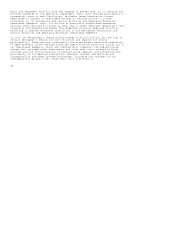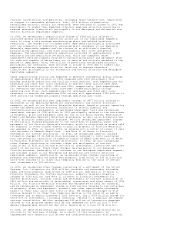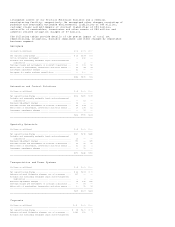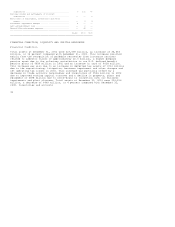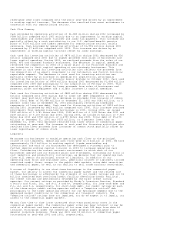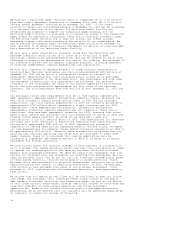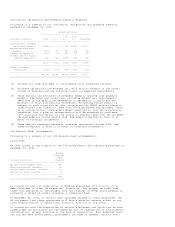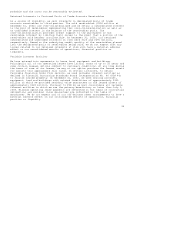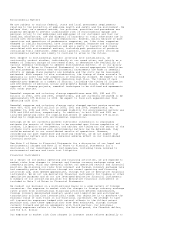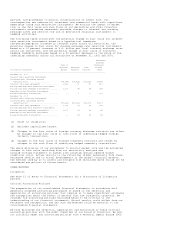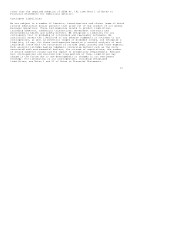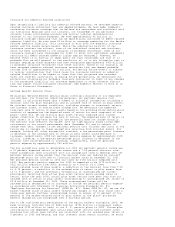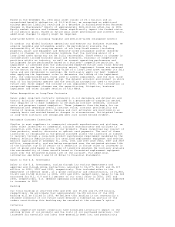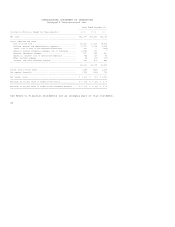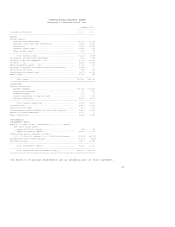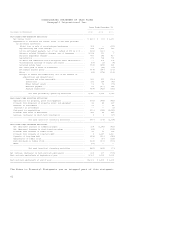Honeywell 2002 Annual Report Download - page 224
Download and view the complete annual report
Please find page 224 of the 2002 Honeywell annual report below. You can navigate through the pages in the report by either clicking on the pages listed below, or by using the keyword search tool below to find specific information within the annual report.Environmental Matters
We are subject to various federal, state and local government requirements
relating to the protection of employee health and safety and the environment. We
believe that, as a general matter, our policies, practices and procedures are
properly designed to prevent unreasonable risk of environmental damage and
personal injury to our employees and employees of our customers and that our
handling, manufacture, use and disposal of hazardous or toxic substances are in
accord with environmental laws and regulations. However, mainly because of past
operations and operations of predecessor companies, we, like other companies
engaged in similar businesses, have incurred remedial response and voluntary
cleanup costs for site contamination and are a party to lawsuits and claims
associated with environmental matters, including past production of products
containing toxic substances. Additional lawsuits, claims and costs involving
environmental matters are likely to continue to arise in the future.
With respect to environmental matters involving site contamination, we
continually conduct studies, individually at our owned sites, and jointly as a
member of industry groups at non-owned sites, to determine the feasibility of
various remedial techniques to address environmental matters. It is our policy
(see Note 1 of Notes to Financial Statements) to record appropriate liabilities
for environmental matters when environmental assessments are made or remedial
efforts or damage claim payments are probable and the costs can be reasonably
estimated. With respect to site contamination, the timing of these accruals is
generally no later than the completion of feasibility studies. We expect to fund
expenditures for these matters from operating cash flow. The timing of cash
expenditures depends on a number of factors, including the timing of litigation
and settlements of personal injury and property damage claims, regulatory
approval of cleanup projects, remedial techniques to be utilized and agreements
with other parties.
Remedial response and voluntary cleanup expenditures were $81, $82 and $75
million in 2002, 2001 and 2000, respectively, and are currently estimated to be
approximately $75 million in 2003. We expect to fund such expenditures from
operating cash flow.
Remedial response and voluntary cleanup costs charged against pretax earnings
were $60, $152 and $110 million in 2002, 2001 and 2000, respectively. At
December 31, 2002 and 2001, the recorded liability for environmental matters was
$435 and $456 million, respectively. In addition, in both 2002 and 2001 we
incurred operating costs for ongoing businesses of approximately $75 million
relating to compliance with environmental regulations.
Although we do not currently possess sufficient information to reasonably
estimate the amounts of liabilities to be recorded upon future completion of
studies, litigation or settlements, and neither the timing nor the amount of the
ultimate costs associated with environmental matters can be determined, they
could be material to our consolidated results of operations. However,
considering our past experience and existing reserves, we do not expect that
environmental matters will have a material adverse effect on our consolidated
financial position.
See Note 3 of Notes to Financial Statements for a discussion of our legal and
environmental charges and Note 21 of Notes to Financial Statements for a
discussion of our commitments and contingencies, including those related to
environmental matters and toxic tort litigation.
Financial Instruments
As a result of our global operating and financing activities, we are exposed to
market risks from changes in interest and foreign currency exchange rates and
commodity prices, which may adversely affect our operating results and financial
position. We minimize our risks from interest and foreign currency exchange rate
and commodity price fluctuations through our normal operating and financing
activities and, when deemed appropriate, through the use of derivative financial
instruments. We do not use derivative financial instruments for trading or other
speculative purposes and do not use leveraged derivative financial instruments.
A summary of our accounting policies for derivative financial instruments is
included in Note 1 of Notes to Financial Statements.
We conduct our business on a multinational basis in a wide variety of foreign
currencies. Our exposure to market risk for changes in foreign currency exchange
rates arises from international financing activities between subsidiaries,
foreign currency denominated monetary assets and liabilities and anticipated
transactions arising from international trade. Our objective is to preserve the
economic value of cash flows in non-functional currencies. We attempt to have
all transaction exposures hedged with natural offsets to the fullest extent
possible and, once these opportunities have been exhausted, through foreign
currency forward and option agreements with third parties. Our principal
currency exposures relate to the Euro, the British pound, the Canadian dollar,
and the U.S. dollar.
Our exposure to market risk from changes in interest rates relates primarily to


